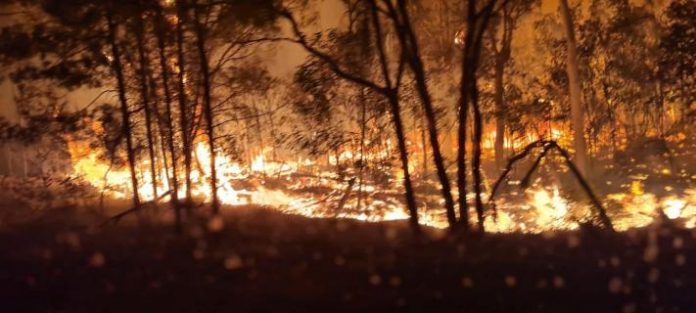By Callum Ludwig
AI-driven research has reaffirmed the threat of the disaster Yarra Ranges residents fear most, bushfire, which would hit the region as hard as expected if a severe blaze broke out.
Property technology company PointData’s Bushfire Risk Index used AI and machine learning to identify the number of buildings and structures at risk due to bushfire in Victoria, New South Wales and Queensland and the cost of rebuilding.
In Victoria, the Yarra Ranges was identified as the region with the most buildings at risk, making up 24,059 of Victoria’s total of 176,329 and almost 12,500 more than the next most at-risk LGA, the Mornington Peninsula. Cardinia was also listed in fifth with 7636 at-risk buildings.
PointData’s Founder and Chief Executive Officer George Giannakodakis said despite the initial relief provided by a wet commencement to summer along the east coast, the enduring threat of bushfire remains strong.
“The consequences of bushfire risk extend far beyond the immediate devasting impacts, as enduring costs are significant, with our analysis suggesting a risk of more than $504 billion to buildings and structures across New South Wales, Queensland and Victoria this summer,” he said.
“The devastating consequences of previous bushfire seasons, such as those witnessed in 2019-2020, serve as a stark reminder of the potential impact on lives, property, and the environment,”
“Adequate planning and understanding the risk on properties and buildings are crucial components of mitigating the potential financial risk of major events.”
PointData’s Bushfire Risk Index measured the building footprint and land parcels in bushfire-risk areas with eligible buildings and structures including residential, commercial and ancillary structures larger than 80 square metres.
CFA District 13’s, which covers the Yarra Ranges, Maroondah and Knox LGAs, Acting Chief Fire Officer David Renkin said it is a reaffirmation of what we already know of the risk in the Yarra Valley and Dandenong Ranges.
“What it means is that it reinforces the need for property owners to consistently manage their fuel loads on their properties to maintain the safety of the property and their families living in these areas,” he said.
“Along with having an appropriate bushfire plan and ensuring that they’re connected to some form of communication so they can receive the community warnings right through the fire season,”
“We utilise the ABC in a lot of these formats and a battery-powered radio is always advisable given the power outages.”
Alerts for serious emergencies can be found online via the VicEmergency app or website, on X (formerly Twitter) at @CFA_Updates or @VicEmergency and Facebook at facebook.com/cfavic or facebook.com/vicemergency, theVicEmergency Hotline (1800 226 226).
With the Fire Danger Period coming into effect in District 13 from 1am Monday 18 December, Mr Renkin said it’s all about vigilance and people reporting fire starts quickly and early.
“This enables us to respond with the appropriate amount of vehicle and personnel to assist in combating that fire and trying to keep that fire as small as possible, though obviously there are days where Mother Nature doesn’t assist us,” he said.
“This year, anything is possible. We’ve certainly had some significant rains in recent times, which is fortunately enough to dampen it down a little bit, but it will only take one or two weeks of decent hot weather to dry out those fuels,”
“I understand the emotional connection people have to their properties, but no one’s life is worth risking to save a property, we can replace the properties but we can’t replace human life.”
6.6 per cent of Victoria’s buildings and structures, including 16.7 per cent of all regional
buildings and structures are at high risk, with a potential rebuilding cost of $144 billion.
Yarra Glen resident and clinical psychologist Dr Rob Gordon OAM, who has specialised in supporting people through disaster recovery, said there is such a huge amount to do when someone has lost everything in a fire.
“People become very quickly focused on the next thing for survival and that means they don’t have the opportunity to feel what it all means, that’s something we can do when we’ve got a bit of free time and opportunity to reflect but there will be so much to do for months after the loss of your house,” he said.
“For most people, it’ll be a few years before they’re settled in a new house and all of that time they’re working very hard and often have very strong feelings of frustration because they’ll be stressed and exhausted on top of if there aren’t tradesmen around or the insurance company delays,”
“It is a very complicated set of feelings involving sadness for what you’ve lost as well as being pleased to have a new house and it takes a big chunk of a few years out of people’s lives.”
Dr Gordon OAM began his work in the field after the 1983 Ash Wednesday fires, assisted with and was caught himself in the 2009 Black Saturday bushfires and has also been called upon for the Port Arthur massacre, the Bali bombings, Covid-19 pandemic recovery, floods and cyclones.
Dr Gordon OAM said the most important thing in his opinion is not so much just the building of the house but keeping your eye on everything that makes the life you’re going to live in that house.
“Your family relationships, your health, your good mood, your engagement with hobbies, activities and interests and all of these things because it’s very common that when people spend a few years in a higher level of stress they don’t put energy into them,” he said.
“Whether it be their relationship with their family or their friends, or they let their golf membership slide because they haven’t got the energy for a while and so on and when they come out the other end, they’re leading much narrower lives,”
“It’s a recipe for finding that at the end of all the recovery, the life you’re leading is not one that you chose and it’s not one that’s enjoyable.”







